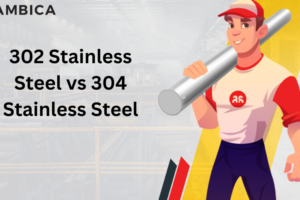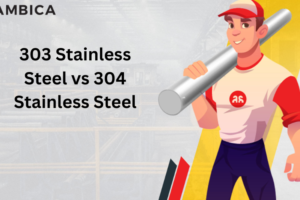DIFFERENCE BETWEEN ss 304 AND 304L AND SS 304 VERSUS 202
Stainless steel is making strides all over the planet. It is a necessary commodity of a flourishing economy and vogue. Stainless has major concerns in production, fabrication, and construction. Its viable types and grades are creating innovation in technology. An example implicating the use of stainless steel in miniature parts of wristwatches to a large panel of designer buildings.
Stainless steel is a large gyration of types and grades. It is an amalgamation of iron, carbon, with at least 10.5% of chromium. The major types of stainless steel are austenitic, ferritic, martensitic, duplex, and precipitation hardening. Each type is mainly comprised of grades according to the chemical composition.
Grade 304 stainless steel is the most common and commercial in the austenitic series. Grade 304L is a low carbon variant of grade 304 only. It is usually available in dual certifications.
Grade 304
Grade 304 is 18/8 stainless steel. Its chemical composition is ascribed as 18% chromium and 8% nickel. The grade 304 is an excellent choice in providing corrosion resistance, forming, welding, deep drawing ability, high-temperature resistance with superior strength at low temperature.
Grade 304L
Grade 304L is a low carbon variant of grade 304. Due to its low carbon content, post-weld annealing is not necessary and it is used in heavy gauge components.
Grade 304L can be welded without the formation of carbide precipitation. As carbide precipitation is a resultant of welding in grade 304. The carbide precipitation is produced when the heat is applied to stainless steel during welding. It depletes the chromium and hence demolishes corrosion prevention property.
Advantages of using 304L
- Low carbon prevents carbide precipitation during the welding.
- Post weld annealing is not required.
- It can perform well in severe corrosive mediums.
Differences between 304 and 304L
Chemical composition
The basic difference between 304 and 304L is carbon content. Grade 304L has .03 % carbon which is good for the welding process.
| Grade | Carbon | Mn | Si | P | S | Cr | Ni | N |
| 304 | 0.08 | 2.0 | 0.75 | 0.045 | 0.030 | 18-20 | 8-10.5 | 0.10 |
| 304L | 0.030 | 2.0 | 0.75 | 0.045 | 0.30 | 18-20 | 8-12 | 0.10 |
Mechanical properties
Grade 304L exhibits slightly lower tensile and yield strength than grade 304.
|
Grade |
Tensile
Strength (Mpa)min |
Yield
Strength 0.2% Proof (Mpa) |
Elongation
(% in 50 mm) |
Hardness
Rockwell B |
| 304 | 515 | 205 | 40 | 92 |
| 304L | 485 | 170 | 40 | 92 |
Weldability
Grade 304L posses improved weldability than the 304.
Applications
Both, Grade 304 304L are commonly used in the food industry, architecture, heat exchangers, and water filtration systems. Grade 304L is typically performed well in chemical applications, mining, construction, and heavy gauge segments.
Difference between grade 304 and grade 202 stainless steel
Grade 304 and 202 are austenitic non-magnetic stainless steel. Both are containing nickel, but the concentration of nickel is not the same. Grade 304 contains 8% nickel, whereas 202 SS has around 4-6% nickel. This makes a huge differentiating parameter between the two.
Grade 304 is vastly used commercial stainless steel. It is also known as 18/8 stainless steel. Grade 304 offers excellent streamline characteristics of corrosion resistance with excellent forming and welding characteristics.
BUY 202 STAINLESS STEEL FINE WIRE
BUY 202 STAINLESS STEEL MIG WELDING WIRE
BUY 202 STAINLESS STEEL TIG WELDING WIRE
Grade 202 is chromium-manganese-nickel stainless steel with high toughness at low temperature.
In comparison, grade 202 has less nickel content unlike 304. Hence it offers low corrosion resistance and lower toughness. But it is a less expensive substitution for grade 304 in many applications.
Chemical Composition
| Grade | Carbon | Mn | Si | P | S | Cr | Ni | N |
| 304 | 0.08 | 2.0 | 0.75 | 0.045 | 0.030 | 18-20 | 8-10.5 | 0.10 |
| 202 | 0.15(max) | 7.50-10 | 1.0 | 0.060 | 0.030 | 17-19 | 4-6 | 0.25 |
The more content of nickel in 304 attributed towards its cost. Grade 304 is more expensive than grade 202.
Mechanical properties
The SS304 and SS202 exhibit comparable tensile and yield strength.
|
Grade |
Tensile
Strength (Mpa)min |
Yield
Strength 0.2% Proof (Mpa) |
Elongation
(% in 50 mm) |
| 304 | 515 | 205 | 40 |
| 202 | 515 | 275 | 40 |
Identification of grade 304 and 202
Both, 320 and 202 are non-magnetic austenitic, so can be differentiated by magnetic testing.
- Material test report should be provided by the manufacturer with detailed descriptive values of chemical composition, physical and mechanical numerical descriptions.
- The grinder test can be used to state the difference between the 304 and 202. On grinding, grade 304 will give red-orange thin emergence, on the other hand, grade 202 yields thick yellow flying sparks.
- Manganese spot and nickel spot test can be used as grade 202 has higher manganese content than 304. Manganese test will turn out to be positive with the appearance of a pink-orange color. The nickel spot will demonstrate pink color.
- X-ray fluorescence spectroscopy can be used and it is a costly method.
- ASTM marking
Weldability of Grade 304 and 202
Grade 304 and 202 both can be welded with the standard fusion method. Grade 202 is not recommended to use the oxyacetylene welding process. The suitable filler is AWS E/ER630. The grade 304 can be welded with grade 308 and 304L electrodes.
BUY 202 STAINLESS STEEL FINE WIRE
BUY 202 STAINLESS STEEL MIG WELDING WIRE
BUY 202 STAINLESS STEEL TIG WELDING WIRE



